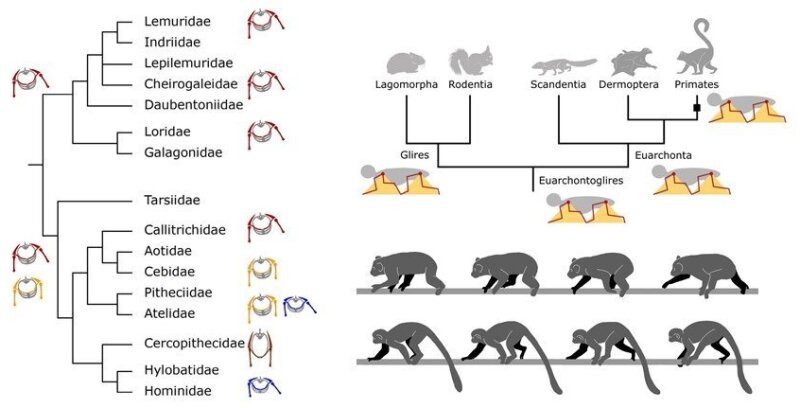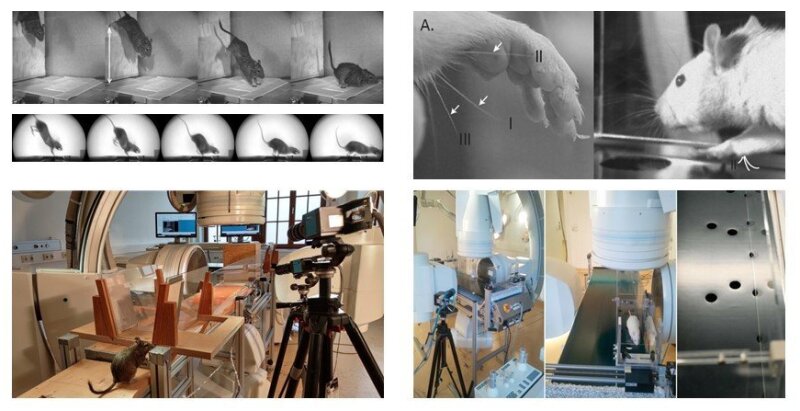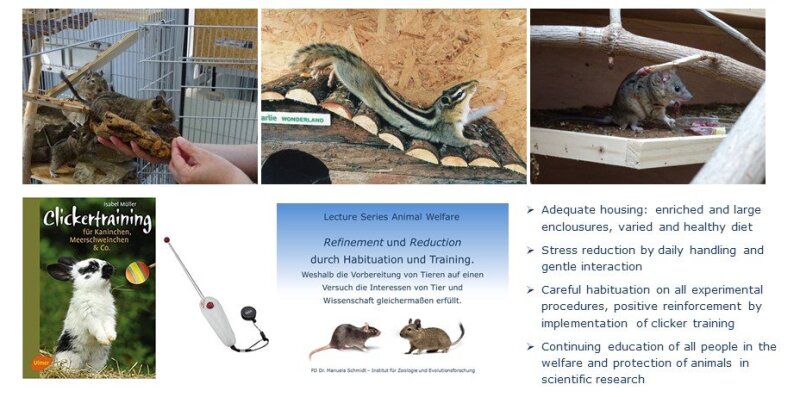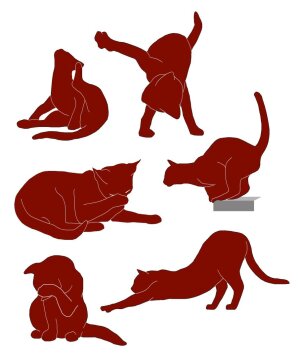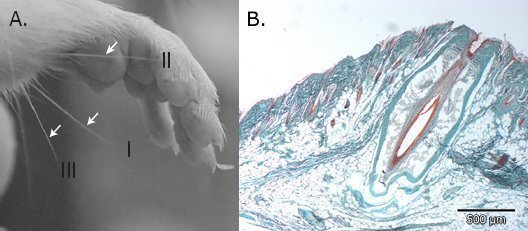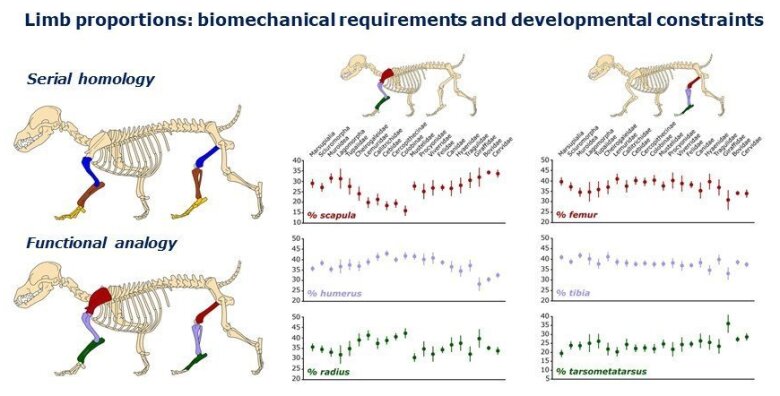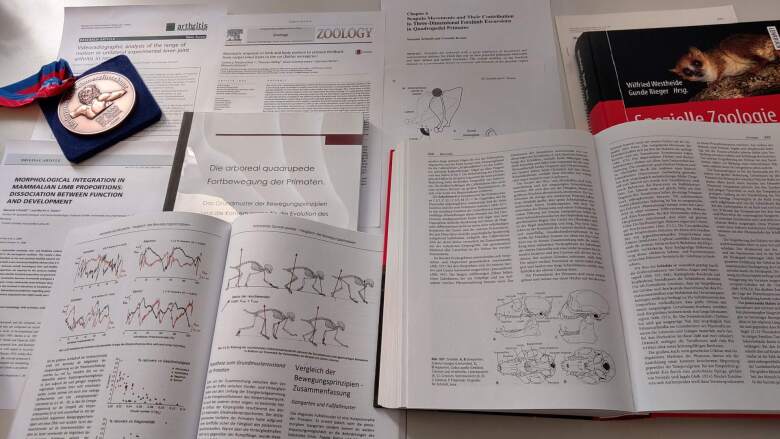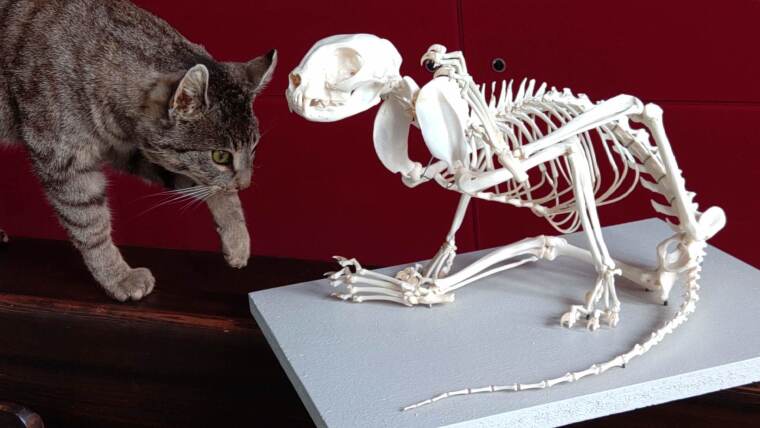
PD Dr. Manuela Schmidt
Image: Manuela SchmidtContact
PD Dr. Manuela Schmidt
Position: Akademische Rätin
Curator of the collections of the Phyletisches Museum
Institute of Zoology and Evolutionary Research
Erbertstrasse 1
07743 Jena
Phone: +49 3641 949188
Email: schmidt.manuela@uni-jena.de
Motion analysis
Small mammals have a particularly versatile movement repertoire. We examine walking on straight and inclined surfaces, on narrow branches and on uneven ground. The analysis of climbing and jumping requires a particularly good preparation of the animals and experimental situations.
Biplanar X-ray fluoroscopy allows a view of the moving structures beneath the fur. Force-sensitive plates determine the forces when running and jumping with high precision.
Experimental situations in the motion lab
Illustration: Manuela SchmidtAnimal welfare in our research activities
Our research and the quality of our data is largely determined by the cooperation of and with animals. Our projects are designed in such a way that the animals do not experience any suffering or pain. We invest a lot of time and patience in the habituation to minimize stress. All people involved in the projects have the required expertise and undergo regular further training. We also share our experiences, e.g. about the advantages of clicker training, in lectures and publications.
Measures to maintain animal welfare
Illustration: Manuela SchmidtThe evolution of body care
Locomotion is not all that ensures survival. Since mammals have had fur, they have also had parasites. Personal hygiene is essential for survival. It not only protects against pathogens transmitted by parasites, but also maintains the functioning of important senses such as hearing and the sense of touch, among others. Body care plays a major role in thermoregulation and social interactions of all kinds. No wonder many species invest more time in daily body care than in other activities.
- We explore, how mammals clean themselves with the particular attention on the range of limb and spine movements. We aim to understand the role of grooming movements in the evolution of the mammalian motion system.
Chipmunks (Tamias sibiricus, Sciuridae) spend a lot of time on daily grooming. By analyzing the spatio-temporal structure of these grooming sequences, we learn which body area is cleaned particularly intensively, which areas are neglected, and how the animals prefer to clean themselves (oral grooming, scratching, "washing" with forepaws).
Involved students:
B.Sc. Celina Richter, M.Sc. Julia van Beesel, M.Sc. Janina Weber
-
Carpal sinus hairs: biological and technical characterization.
A. Carpal sinus hairs on the rat's forepaw. B. Longitudinal section of the follicle-sinus-complex.
Image: Sandra Niederschuh, Manuela SchmidtMany small-sized mammals have three or more sinus hairs near the wrist joint of the forelimb, called “carpal vibrissae”. Sandra Niederschuh in her Doctoral thesis project investigates the function of these hairs as feedback sensors during locomotion. She analysed the effect of removal of these hairs (they regenerate within two weeks) on limb kinematics and body posture.
Our biological perspective on carpal vibrissae is embedded in a collaborative project with engineers and scientists of the Technical University Ilmenau. Together, we explore how technical solutions for lever-based mechanosensors can be realized according to the function of vibrissae.
Project partners:
- Prof. Dr.-Ing. habil. Klaus Zimmermann (Dept. of Mechanical Engineering, TU Ilmenau)
- Prof. Dipl.-Ing. Dr. med. habil. Hartmut Witte (Dept. of Biomechatronics, Technical University Ilmenau)
Funding:
German Research Foundation (2013, 2015): Technical, non-visual characterization of substrate contacts using carpal vibrissae as a biological model.
-
Diagnostic potential of motion analysis.
Behavioural and performance analyses become of increasing importance as diagnostic tools in preclinical medical research and genetics. But, linking anatomy and physiology with behaviour and performance is difficult because of individual variation and flexibility in the latter. The analysis of motion principles e.g. the footfall patterns of gaits, the measures of speed changes, limb and body kinematics or substrate reaction forces in animal models for diseases or in mutants has the potential to explain observed differences in performance and behaviour between treated and control individuals.
Evolutionary morphology also profit from such studies by learning much about intraspecific physiological and functional plasticity of the motion system, about morphological integration and about the ability to compensate for a lesion in the central nervous system, for a dysfunction of a certain joint or for an genetic aberration.
Projects and funding:
- The Role of the Wilms Tumor Suppressor Gene Wt1 in the Neural Control of Locomotion in Mice. Partners: Prof. Dr. Christoph Englert, Dr. Danny Schnerwitzki (Research Group Molecular genetics, Leibnitz Institute on Aging: Fritz Lipmann Institute).
- Integrative and diagnostic potential of detailed motion analyses in pain research. Partners: Dr. Michael Böttger, Johannes Leuchtweis, Prof. Dr. Hans-Georg Schaible (Institute of Physiology I / Neurophysiology, University Hospital Jena). Funding: ProChance, Program for the promotion of equal opportunities for women and men in science (2009).
-
Morphological integration in mammalian limb proportions.
Morphological integration: Limb proportions of mammals
Graphic: Manuela SchmidtDuring mammalian evolution, fore- and hindlimbs underwent a fundamental reorganization in the transformation from the sprawled to the parasagittal condition. This caused a dissociation between serial and functional homologues. The mobilized scapula functions as the new proximal forelimb element and is functionally analogous to the femur of the hindlimb. Tarsus and metatarsus built a new functional hindlimb element that is functionally analogous to the forearm of the forelimb. Morphological covariation between serially homologous fore- and hindlimb elements can conflict with biomechanical demands when certain intralimb proportions are required for the postural stability of motion.
In our studies we found a clear relationship between the proportions of the first and the third elements of each limb, while the middle element is less involved in alterations of intralimb proportions. Hindlimb proportions are largely uniform across mammals and correspond to biomechanical predictions regarding postural stability. The greater variability in forelimb proportion is likely be the expression of various adaptations but might results also from constraints due to the shared developmental programs with the hindlimb.
Project partners:
- Prof. Dr. André Seyfarth (today: Dept. of Sports Biomechanics, Institute of Sport Sciences, Technical University Darmstadt)
- Prof. Dr. Lena Zentner (today: Research Group Compliant systems, Technical University Ilmenau)
Funding:
Promotion of excellent scientific activities at Thuringian universities (2005 - 2010): Junior research group "Functional morphology of motion systems".
German Research Foundation (2006-2009): Body size related strategies in the self-stability of limb motion. (Fischer & Schmidt)
-
The evolution of primate locomotion: reconstructing the basic pattern and subsequent transformations.
Inhalt
-
Functional morphology of the primate shoulder.
Projektförderung:
DFG Projekt (2005 - 2008): Verteiling der Muskelfasertypen in der Schultermuskulatur arborealer Primaten in Relation zu Schulterbewegung und Belastung.
-
2020 - today
Book chapters, monographs and key research papers
Image: Manuela Schmidt- Schnerwitzki, D.; Englert, C.; Schmidt, M. (2023): Adapting the pantograph limb: Differential robustness of fore- and hindlimb kinematics against genetically induced perturbation in the neural control networks and its evolutionary implications. Zoology 157. doi: 10.1016/j.zool.2023.126076.External link
- Niederschuh, S.J.; van Beesel, J.; Schmidt, M. (2022): The role of sensory feedback from carpal sinus hairs in locomotor kinematics of rats (Rattus norvegicus, Rodentia) during walking on narrow substrates. Zoology 155. doi.org/10.1016/j.zool.2022.126055External link.
-
2015 - 2019
- Schnerwitzki, D.; Perry, S.; Ivanova, A.; Caixeta, F.V.; Cramer, P.; Günther, S.; Weber, K.; Tafreshiha, A.; Becker, L.; Vargas Panesso, I.L.; Klopstock, T.; Hrabe de Angelis, M.; Schmidt, M.; Kullander, K.; Englert, C. (2018): Neuron-specific inactivation of Wt1 alters locomotion in mice and changes interneuron composition in the spinal cord. Life Science Alliance e201800106. doi: 10.26508/lsa.201800106.External link
- Niederschuh, S.; Helbig, T.; Zimmermann, K.; Witte, H.; Schmidt, M. (2017): Kinematic response in limb and body posture depending on sensory feedback from carpal sinus hairs in the rat (Rattus norvegicus). Zoology 121, 18-34. IF 1.59
- Schmidt, M.; Mehlhorn, M.; Fischer, M.S. (2016): Shoulder girdle rotation, forelimb movement, and the influence of carapace shape on locomotion in Testudo hermanni (Testudinidae). Journal of Experimental Biology 219, 2693-2703. IF 3.02
- Volkova, T.; Zeidis, I.; Witte, H.; Schmidt, M.; Zimmermann, K. (2016): Analysis of the vibrissa parametric resonance causing a signal amplification during whisking behaviour. Journal of Bionic Engineering 13, 312-323. IF 2.46
- Hunt, A.; Schmidt, M.; Fischer, M.; Quinn, R. (2015): A Biologically Based Neural System Coordinates the Joints and Legs of a Tetrapod. Bioinspiration and Biomimetics 10, 055004. IF 3.13
- Niederschuh, S.; Witte, H.; Schmidt, M. (2015): The role of vibrissal sensing in forelimb position control during travelling locomotion in the rat (Rattus norvegicus, Rodentia). Zoology 118, 51-62. IF 1.59
- Hesse, B.; Nyakatura, J.A.; Fischer, M.S.; Schmidt, M. (2015): Adjustments of limb mechanics in cotton-top tamarins to moderate and steep support orientations: significance for the understanding of early primate evolution. Journal of Mammalian Evolution 22, 435-450. IF 2.38
-
2010 - 2014
- Helbig, T.; Voges, D.; Niederschuh, S.; Schmidt, M.; Witte, H. (2014): Characterizing the substrate contact of carpal vibrissae of rats during locomotion. In: Biomimetic and Biohybrid Systems. Lecture Notes in Computer Science Volume 8608, pp 399-401.
- Hunt, A.; Schmidt, M.; Arnold, D.; Fischer, M.; Quinn, R. (2014): Neuromechanical simulation of inter-leg controller for tetrapod coordination. In: Biomimetic and Biohybrid Systems. Lecture Notes in Computer Science Volume 8608, pp 142-153.
- Schmidt, M.; Witte, H.; Zimmermann, K.; Niederschuh, S.; Helbig, T.; Voges, D.; Husung, I.; Volkova, T.; Will, C.; Behn, C.; Steigenberger, J.; Klauer, G. (2014): Technical, non-visual characterization of substrate contact using carpal vibrissae as a biological model : an overview. In: Shaping the future by engineering : 58th IWK, Ilmenau Scientific Colloquium, Technische Universität Ilmenau, 15 p.
- Helbig, T.; Voges, D.; Niederschuh, S.; Schmidt, M.; Witte, H. (2014): Characterizing the substrate contact of carpal vibrissae of rats during locomotion. In: Biomimetic and Biohybrid Systems. Lecture Notes in Computer Science Volume 8608, pp 399-401.
- Hunt, A.; Schmidt, M.; Arnold, D.; Fischer, M.; Quinn, R. (2014): Neuromechanical simulation of inter-leg controller for tetrapod coordination. In: Biomimetic and Biohybrid Systems. Lecture Notes in Computer Science Volume 8608, pp 142-153.
- Schmidt, M.; Witte, H.; Zimmermann, K.; Niederschuh, S.; Helbig, T.; Voges, D.; Husung, I.; Volkova, T.; Will, C.; Behn, C.; Steigenberger, J.; Klauer, G. (2014): Technical, non-visual characterization of substrate contact using carpal vibrissae as a biological model : an overview. In: Shaping the future by engineering : 58th IWK, Ilmenau Scientific Colloquium, Technische Universität Ilmenau, 15 p.
- Böttger, M.K; Leuchtweis, J.; Schaible, H.-G.; Schmidt, M. (2011): Videoradiographic analysis of the range of motion in unilateral experimental knee joint arthritis in rats. Arthritis Research and Therapy 13, R79. IF 4.27
- Schmidt, M. (2011): Locomotion and postural behaviour. Advances in Science and Research 5, 23-39.
- Preuschoft, H.; Hohn, B.; Scherf, H.; Schmidt, M.; Krause, C.; Witzel, U. (2010): Functional analysis of the primate shoulder. International Journal of Primatology 31, 301-320. IF 1.29
-
2000 - 2009
- Böttger, M.K.; Weber, K.; Schmidt, M.; Gajda, M.; Bräuer, R.; Schaible, H.-G. (2009): Gait abnormalities differentially indicate pain or structural joint damage in monoarthicular antigen-induced arthritis. Pain 145, 142-150. IF 6.03
- Schmidt, M.; Fischer, M.S. (2009): Morphological integration in mammalian limb proportions: dissociation between function and development. Evolution 63, 749-766. IF 3.57
- Schmidt, M. (2008): Forelimb proportions and kinematics: How are small primates different from other small mammals? Journal of Experimental Biology 211, 3775-3789. IF 3.02
- Schmidt, M.; Schilling, N. (2007): Fiber type distribution in the shoulder muscles of tree shrews, cotton-top tamarins, and squirrel monkeys related to shoulder movements and forelimb loading. Journal of Human Evolution 52, 401-419. IF 3.99
- Nyakatura, J.; Fischer, M.S.; Schmidt, M. (2007): Gait parameter adjustments of cotton-top tamarins (Saguinus oedipus, Callitrichidae) to locomotion on inclined arboreal substrates. American Journal of Physical Anthropology 135, 13-26. IF 2.82
- Schmidt, M. (2005): Quadrupedal locomotion in squirrel monkeys (Cebidae: Saimiri sciureus) – A cineradiographic study of limb kinematics and related substrate reaction forces. American Journal of Physical Anthropology 128, 359-370. IF 2.82
- Schmidt, M. (2005): Hind limb proportions and kinematics: are small primates different from other small mammals? Journal of Experimental Biology 208, 3367-3383. IF 3.02
- Preuschoft, H.; Schmidt, M.; Hayama, S.; Okada, M. (2003): The influence of three-dimensional movements of the forelimb on the shape of the thorax and its importance for erect body posture. Courier Forsch.-Inst. Senckenberg 243, 9-24.
- Witte, H.; Fischer, M.S.; Schmidt, M.; Gruber, S.; Ludwig, O.; Hackert, R.; Schilling, N.; Voges, D.; Hoffmann, H.; Preuschoft, H. (2003): Human bipedality: mechanical preconditions and morphological adaptations. Courier Forsch.-Inst. Senckenberg 243, 25-34.
- Fischer, M.S.; Schilling, N.; Schmidt, M.; Haarhaus, D.; Witte, H. (2002): Basic limb kinematics of small therian mammals. Journal of Experimental Biology 205, 1315-1338. IF 3.02
- Schmidt, M.; Voges, D.; Fischer, M.S. (2002): Shoulder movements during quadrupedal locomotion in arboreal primates. Z. Morph. Anthropol. 83, 235-242.
- Witte, H.; Biltzinger, J.; Hackert, R.; Schilling, N.; Schmidt, M.; Reich, C.; Fischer, M.S. (2002): Torque patterns of the limbs of small therian mammals during locomotion on flat ground. Journal of Experimental Biology 205, 1339-1353. IF 3.02
- Schmidt, M.; Fischer, M.S. (2000): Cineradiographic study of forelimb movements during quadrupedal locomotion in the brown lemur (Eulemur fulvus, Primates: Lemuridae). American Journal of Physical Anthropology 111, 245-262. IF 2.82
-
Book chapters and monographs
Book chapters
- Schmidt, M. (2014): Primates. In: Lehrbuch der Speziellen Zoologie. Band 2 Wirbel- oder Schädeltiere. 3. Aufl. (eds. W. Westheide & G. Rieger) pp. 564-592. Spektrum Verlag, Heidelberg.
- Schmidt, M.; Krause, C. (2011): Scapula movements and their contribution to three-dimensional forelimb excursions in quadruped primates. In: Primate Locomotion: Linking Field and Laboratory Research. (eds. K. D’Aout & E.E. Vereecke). pp. 83-108. Book in the series “Developments in Primatology: Progress and Prospects” Series Editor R.H. Tuttle, Springer Science & Business Media LLC, New York.
- Schmidt, M. (2010): Primates. In: Lehrbuch der Speziellen Zoologie. Band 2 Wirbel- oder Schädeltiere. 2. Aufl. (eds. W. Westheide & G. Rieger) pp. 564-592. Spektrum Verlag, Heidelberg.
- Schmidt, M. (2006): Primate Locomotion. In: Encyclopedia of Anthropology. (ed. J. Birx) pp. 1938- 1939. SAGE Publications, Thousand Oaks, California.
- Witte, H.; Hackert, R.; Lilje, K.E.; Schwerda, D.; Schilling, N.; Schmidt, M.; Freitag, S.; Seyfarth, A.; Ilg, W.; Blickhan, R.; Fischer, M.S. (2001): Some principles and some constraints of scaling in the locomotor apparatus of quadruped animals and animates. In: Similarity Methods. (eds. B. Kröplin, S. Rudolph, S. Brückner) pp. 149-151. Institut für Statik und Dynamik der Raumfahrtkonstruktionen der Universität Stuttgart, Stuttgart.
- Witte, H.; Schilling, N.; Hoffmann, H. Hackert, R.; Voges, D.; Lilje, K.E.; Schmidt, M.; Fischer, M.S. (2002): Der Rumpf wird vom Menschen und von anderen Säugetieren systematisch für die Fortbewegung genutzt. In: Prävention von arbeitsbedingten Gesundheitsgefahren und Erkrankungen. (eds. R. Grieshaber, W. Schneider & Scholle, H.C.) pp. 291-304. 8. Erfurter Tage. Monade Agentur für Kommunikation, Leipzig.
Monographs
- Schmidt, M. (2010): Die arboreal quadrupede Fortbewegung der Primaten. Das Grundmuster der Bewegungsprinzipien und die Konsequenzen für die Evolution des Bewegungssystems der Primaten.“ Habilitation thesis.External link 1-152.

